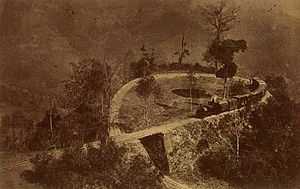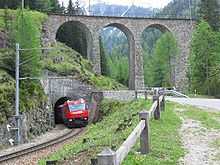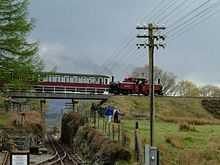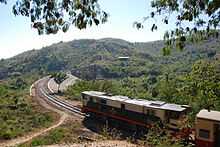Spiral (railway)

A spiral (sometimes called a spiral loop or just loop) is a technique employed by railways to ascend steep hills.
A railway spiral rises on a steady curve until it has completed a loop, passing over itself as it gains height, allowing the railway to gain vertical elevation in a relatively short horizontal distance. It is an alternative to a zig-zag, and avoids the need for the trains to stop and reverse direction while ascending. If the train is of sufficient length, it is possible to view the train looping onto itself.
A spiral loop should not be confused with the transition spiral or spiral easement used to provide a transition from a tangent into a horizontal circular curve. Spiral easement is used to avoid abrupt changes in the sideward acceleration experienced by a railroad vehicle and the passengers in the vehicle approaching the horizontal circular curve and to prevent abrupt forces and discomfort. These curves are also used in highway engineering.
A similar feature to railway spirals in road design is the pigtail bridge.
Calculations
On a railway climbing at a gradient of 1 in 40 (2.5%, or 25 m per km) a 360-degree spiral at 350 m radius will add 2200 m to the forward journey and 55 m to the vertical climb. Unless the topography has a suitably shaped hill, the spiral is likely to include a tunnel, increasing construction costs and creating problems if steam locomotives are employed. If a convenient side valley is available, then a horseshoe curve may be possible.
The spiral needs to climb about 6 m in order to bridge itself. With steam locomotives and to a lesser extent with diesel locomotives, the gradient in any long tunnel(s) should be less than the ruling grade to avoid problems with fumes and dampness causing the driving wheels to slip.
List of spirals
- This list is incomplete; you can help by expanding it.
Argentina
- 2 spirals south of Diego de Almagro station on theTren a las Nubes line
Australia
- Bethungra Spiral two very short tunnels, uphill track in spiral at 1 in 66 gradient, downhill track plain at 1 in 40 gradient
- Cougal Spiral one short and one long tunnel, single track
Austria
- An early spiral on the Brenner Railway is apparently called a winding.[1]
Bolivia
- Spiral south of Zudáñez on closed railway line starting at Taburoco
Bulgaria
- 4 spirals at Septemvri – Dobrinishte railway 760 mm (2 ft 5 15⁄16 in) gauge.
- Klisura – 3rd main railway line, the spiral is built around the town
- 2 spirals at Radevtsi and Raduntsi on 4th mainline.
Canada
- Spiral tunnels between Field, BC, and the summit of Kicking Horse Pass, Canadian Pacific Railway. 51°26′10″N 116°24′13″W / 51.435976°N 116.403653°W
- Trinity Loop[2] near Trinity, Newfoundland
- The Newfoundland Railway no longer exists
- Rogers Pass
Chile
- Trans-Andine Railway connecting Chile and Argentina
People's Republic of China
- Yangjiawan – Qinling Tunnel
- On the Chengdu-Kunming Railway, there is a spiral north of Heijing Town
Croatia
- Tunnel 1838 m long (0+525 - 2+363) between Rijeka-Brajdica and Sušak-Pećine stations on the southern approach to the Rijeka-Karlovac railway, part of International corridor V.
France
- Sayerce tunnel between Pau and Zaragossa (Spain) in the Pyrenees[4]
- Nice-Cuneo (Italy), three spirals.
- Moûtiers, between Albertville and Bourg-Saint-Maurice (Savoie), (45°29′08″N 6°32′26″E / 45.485628°N 6.540444°E) used by TGV.
- The proposed four-turn spiral of Gravenne de Montpezat (44°41′42″N 4°13′05″E / 44.695047°N 4.21797°E) on the partly completed Ligne Transcévenole between Saint-Cirgues and Aubenas (Ardèche) in the Cévennes[5] was never constructed.
Germany
- Rendsburg Rendsburg High Bridge, northern approach. Unique oblong single loop onto the transporter bridge crossing the Kiel Canal
- The Wutach Valley Railway had to be built less steep than possible to haul heavy military trains over it, since it bypassed for the shorter Singen–Waldshut route crossing Swiss territory.
India

- Darjeeling Himalayan Railway (DHR) has three (originally five) loops, of which one is a double spiral. 2 ft (610 mm) gauge
- Between Khandwa and Hingoli, 1,000 mm (3 ft 3 3⁄8 in) metre gauge[6]
Iran
- Numerous spirals through very mountainous regions, mostly entirely in tunnel and single track, e.g. the Three Golden Lines.
Ireland
- The St. James's Gate Brewery, Dublin, Ireland had an internal 1 ft 10 in (559 mm) gauge railway with a loop in a tunnel to gain height between buildings[7]
Italy
- At Sassari-Palau railway on the Ferrovie della Sardegna.
- At Mandas-Gairo-Arbatax railway close to Lanusei railway station on the Ferrovie della Sardegna.
- At Iselle di Trasquera on the SBB.
- At Vernante on the FS.
- Close to Savona on the Savona-Altare line on the FS.
- At Caprareccia and San Martino on the Spoleto-Norcia line there were in total three spirals.
- At Salerno on the Salerno-Mercato San Severino line.
- At Casole Bruzio on the Cosenza-San Giovanni in Fiore line.
- At Ragusa on the FS.
- At Varzo on the Italian approaches to the Simplon tunnel.[8]
Japan

- Jōetsu Line has two spirals, track towards Tokyo only
- Hokuriku Main Line from Tsuruga Station to Shin-Hikida Station, track for Maibara Station only
- Hisatsu Line between Yatake Station and Okoba Station, with a zig zag in the loop
- Tosa Kuroshio Railway Nakamura Line between Kawaoku S.B. and Kaina Station
- Yurikamome, western approach to the Rainbow Bridge
Kenya
Mazeras Spiral near Mombasa, at: -3.995257° 39.546742° (map)
Spiral near Makutano station, at: -0.043457° 35.641461°
Spiral near Equator station, at: -0.007183° 35.551033°
South Korea

- Geumdae 2nd Tunnel – between Geumgyo station and Chiak station on Jungang Line – one loop, single track. New double track tunnel is under construction to replace loop tunnel.
- Daegang Tunnel – between Danseong station and Jungnyeong station on the Jungang Line – one loop, single track.
- Hambaek 1st Tunnel – between Hambaek station and Jodong station on the Hambaek Line – one loop, single track.
- Solan Tunnel – between East Baeksan station and Dogye station on the Yeongdong Line – one loop, single track but double track is installed on the middle of the tunnel; for both trains crossing each other. It will be opened in 2009.
Madagascar
- One loop at Anjiro on the main line from Antananarivo to Toamasina.
Myanmar
- Two spirals on the Burmah Mines Railway[9]
- One spiral close to Schwenyaung on the Thazi-Schwenyuang line
New Zealand
- Raurimu Spiral on the North Island Main Trunk, single track, suitable hill, two short tunnels. See Map and Photo.
- Driving Creek Railway
- Ellis & Burnand Ongarue tramway (closed 1958, now a cycle trail).
Norway
- Flåm Line: between Myrdal and Flåm – tunnels that spiral in and out of the mountainside.
- Rauma Line: near the Kylling Bridge
Russia
- Bolshoy Petlevoy (ru), Sredniy Petlevoy and Maly Petlevoy Tunnels (Major, Middle and Minor Loop Tunnels) – 3 tunnels on a single loop of North Caucasus Railway (44°15′41″N 39°14′54″E / 44.2615°N 39.248306°E)
Serbia
- Šarganska osmica in Western Serbia, from Mokra Gora to Šargan Vitasi.
Slovakia
- Telgart Loop (Telgártska slučka – Slovak language)
South Africa
- South Africa There is a spiral on the descent to the Great Kei river on the branch line to Mthatha.[10]
- At the Zand River crossing on the Bloemfontein to Kroonstad line the high-level bridge was destroyed by fighting in the second Boer War. Spiral tracks were constructed by military engineers to access a temporary bridge at river level.[11]
Spain
- Cargol Tunnel on the Ripoll - La Tour de Carol (France) line
- El Lazo Tunnel on the Palencia - La Coruña line
Sri Lanka
- Demodera
Switzerland


- Gotthardbahn has five spirals (and two turns), entirely in tunnel, double track, standard gauge
- RhB Albulabahn has four spirals (in tunnels), single track, metre gauge
- RhB Berninabahn has an open spiral mainly on the Brusio spiral viaduct (near Brusio), single track, metre gauge
- Former Furka-Oberalp-Bahn, now Dampfbahn Furka-Bergstrecke heritage railway, has one spiral tunnel, single track, cog rail, metre gauge, catenary removed
- Former Furka-Oberalp-Bahn, now Matterhorn-Gotthard-Bahn, between Grengiols and Lax, single track, metre gauge, cog rail, entirely in tunnel
Taiwan
Uganda
- See Kenya above.
United Kingdom

- Dduallt Loop, Ffestiniog Railway in Wales, 1 ft 11½ in (597 mm) gauge
- The line from Moorswater cement terminal, through Coombe Junction and Liskeard on the Looe Valley Line and on over Moorswater Viaduct forms a complete spiral, climbing up to join the main line at Liskeard. Not all parts are used by passenger trains.
United States

- California, Williams Loop
- California, Tehachapi Loop
- California, Roaring Camp Loop – 3 ft (914 mm) gauge (abandoned after fire, trestles still partly standing, to be rebuilt)
- Tennessee, Hiwassee Loop, in which the track wraps around a hill twice and crosses over itself on an 80-foot-tall (24 m) trestle.
- Colorado, Georgetown Loop
- Colorado, Riflesight Notch Loop on the Moffat Route, west of Rollins Pass (line abandoned, replaced by Moffat Tunnel, trestle still partly standing)
- Colorado, Ophir Loop – Rio Grande Southern Railroad – 3 ft (914 mm) gauge (abandoned)
- Dunderberg Spiral Railway (never completed)
- Eureka, Utah – the "Golden Circle".
Spirals are not generally needed on tramways (street running or reserved track) or light rail lines because trams traditionally have all wheels powered, giving the ability to climb much steeper direct gradients than railways.
Roads
Roads sometimes use a spiral to gain height in a confined space, cf. pigtail bridge.
See also
- Hairpin turn
- Horseshoe curve
- Spiral tunnels and tunnels on a curved alignment
References
- ↑ "FEATS IN RAILWAY ENGINEERING.". The Darling Downs Gazette and General Advertiser (Toowoomba, Qld. : 1858–1880) (Toowoomba, Qld.: National Library of Australia). 25 August 1868. p. 4. Retrieved 7 January 2013.
- ↑ Trinity Loop
- ↑ "TRANS-ANDINE RAILWAY.". The West Australian (Perth, WA : 1879–1954) (Perth, WA: National Library of Australia). 30 November 1909. p. 5. Retrieved 23 March 2013.
- ↑
- ↑ fr:Ligne transcévenole
- ↑ irfca.org
- ↑
- ↑ "THE SIMPLON TUNNEL.". The Capricornian (Rockhampton, Qld : 1875–1929) (Rockhampton, Qld: National Library of Australia). 15 October 1904. p. 21. Retrieved 19 March 2013.
- ↑
- ↑ Can be clearly seen on Google Maps
- ↑ Childers, Erskine (1900). In the Ranks of the C. I. V. London: Smith, Elder. p. 86. OCLC 16633317.
External links
| ||||||||||||||||||||
